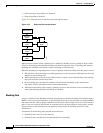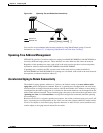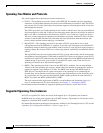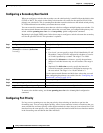
16-13
Catalyst 2960 and 2960-S Switch Software Configuration Guide
OL-8603-09
Chapter 16 Configuring STP
Configuring Spanning-Tree Features
Default Spanning-Tree Configuration
Table 16-3 shows the default spanning-tree configuration.
Spanning-Tree Configuration Guidelines
Each stack member runs its own spanning tree, and the entire stack appears as a single switch to the rest
of the network.
If more VLANs are defined in the VTP than there are spanning-tree instances, you can enable PVST+
or rapid PVST+ on only 128 VLANs on each switch stack. The remaining VLANs operate with spanning
tree disabled. However, you can map multiple VLANs to the same spanning-tree instances by using
MSTP. For more information, see Chapter 17, “Configuring MSTP.”
If 128 instances of spanning tree are already in use, you can disable spanning tree on one of the VLANs
and then enable it on the VLAN where you want it to run. Use the no spanning-tree vlan vlan-id global
configuration command to disable spanning tree on a specific VLAN, and use the spanning-tree vlan
vlan-id global configuration command to enable spanning tree on the desired VLAN.
Caution Switches that are not running spanning tree still forward BPDUs that they receive so that the other
switches on the VLAN that have a running spanning-tree instance can break loops. Therefore, spanning
tree must be running on enough switches to break all the loops in the network; for example, at least one
Table 16-3 Default Spanning-Tree Configuration
Feature Default Setting
Enable state Enabled on VLAN 1.
For more information, see the “Supported
Spanning-Tree Instances” section on
page 16-10.
Spanning-tree mode PVST+. (Rapid PVST+ and MSTP are
disabled.)
Switch priority 32768.
Spanning-tree port priority (configurable on a per-interface basis) 128.
Spanning-tree port cost (configurable on a per-interface basis) 1000 Mb/s: 4.
100 Mb/s: 19.
10 Mb/s: 100.
Spanning-tree VLAN port priority (configurable on a per-VLAN basis) 128.
Spanning-tree VLAN port cost (configurable on a per-VLAN basis) 1000 Mb/s: 4.
100 Mb/s: 19.
10 Mb/s: 100.
Spanning-tree timers Hello time: 2 seconds.
Forward-delay time: 15 seconds.
Maximum-aging time: 20 seconds.
Transmit hold count: 6 BPDUs


















